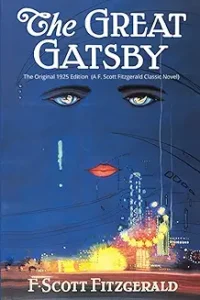The Great Gatsby by F. Scott Fitzgerald 1925
“So we beat on, boats against the current, borne back ceaselessly into the past.” This, the final sentence of F. Scott Fitzgerald’s ‘The Great Gatsby’ is one of the most famous lines in fiction and the conclusion of what many critics call the ‘great American novel’.
I’ve now read ‘The Great Gatsby’ at least for the third time, but this time felt completely different. Perhaps it was the play we saw at the Northern Stage Theater in White River Junction last month in which one actor speaking the actual words from the novel, portrayed at least a dozen characters. I’ve seen another stage production based on the book, ‘Gatz’ at the ART in Cambridge in which actors read the entire book while on stage. And, if that were not enough, we are scheduled to see a production of ‘Gatsby’ at the ART this month, with the book written by Pulitzer Prize-winning Martyna Majok, a musical score by Oscar and Grammy nominated Thomas Bartlett, and directed by Tony Award winner Rachel Chavkin.
What other American novel has stimulated so many dramatic treatments, so many movie versions, and so much critical acclaim! And, why???
I must admit that I read the book differently this time, much more slowly, carefully, and with an eye towards answering these questions, and I believe that the answer lies in the writing. Fitzgerald’s writing is spectacular. Its pace, language, and focus on the details contribute to the feeling that one is being swept along by a torrent of action, characters, and settings that the reader can’t resist.
The plot is surely familiar to nearly every reader since they’ve almost certainly read the book in high school or college, but if you don’t want me to spoil it for you, skip this paragraph. It’s 1922 and Nick Carraway, a 27 year old Yale graduate and veteran of WWI rents a small cottage in West Egg on Long Island, 22 miles from Manhattan, after fleeing his Midwest family and taking up bond trading in the Big Apple. His cottage abuts the huge property and mansion of Jay Gatsby, a mysterious presence whose weekend parties fill Carraway’s nights with music, champagne, and the fast crowd of the Roaring 20’s New York. Across the water, in East Egg, Daisy Buchanan, a distant cousin of Nick’s lives in another gaudy, overdone mansion with her husband Tom, their daughter, and her friend, Jordan Baker. Gatsby is in love with Daisy whom he courted in Louisville five years earlier before going off to fight heroically in WWI in France. Daisy returns his feelings but ultimately can’t leave Tom, and in a drunken drive back from the Plaza Hotel, she kills Tom’s mistress, Myrtle Wilson, in Gatsby’s car. Mad with grief and anger, Wilson murders Gatsby thinking it was him driving the car. Gatsby’s funeral is a solemn and tragic affair with only his poor father from North Dakota, Nick, and the owl-eyed man from the library in attendance. Daisy and Tom disappear, Jordan is engaged to another, and Nick returns to his St. Paul roots, a wiser, sadder, and more grounded man. Whew!
So why does this novel remain the classic that it is? Perhaps it’s the relationship of writer and editor—Fitzgerald and Maxwell Perkins. Perhaps it’s the famous cover painting by a little known Barcelonan artist, Francisco Cougat, that has lived on in ‘the best cover’ collections. Perhaps it’s the mix of war, the Roaring 20’s, the contrast between the rich Buchanans and Gatsby and the poor Wilsons. Perhaps it’s the American dream of creating one’s self despite unimpressive roots as Gatsby moves from a poor, hungry hobo to a rich bootlegger. Or perhaps it’s all of these plus an incredibly beautifully written text.
At any rate, I have a feeling that ‘The Great Gatsby’ will remain as a top contender for the Great American Novel for some time. Read it, but read it slowly and carefully to fully appreciate the artistry and beauty of what Fitzgerald has done.
s



